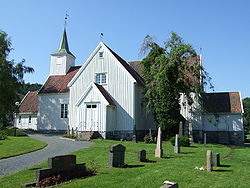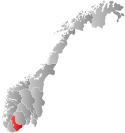Landvik
 From Wikipedia - Reading time: 9 min
From Wikipedia - Reading time: 9 min
Landvik Municipality
Landvik kommune | |
|---|---|
| Landvig herred (historic name) Hommedal herred (historic name) | |
 View of the local church | |
 Aust-Agder within Norway | |
 Landvik within Aust-Agder | |
| Coordinates: 58°20′24″N 08°31′13″E / 58.34000°N 8.52028°E | |
| Country | Norway |
| County | Aust-Agder |
| District | Østre Agder |
| Established | 1 Jan 1838 |
| • Created as | Formannskapsdistrikt |
| Disestablished | 1 Jan 1971 |
| • Succeeded by | Grimstad Municipality |
| Administrative centre | Roresanden |
| Area (upon dissolution)[1] | |
• Total | 223.1 km2 (86.1 sq mi) |
| Population (1971) | |
• Total | 2,781 |
| • Density | 12/km2 (32/sq mi) |
| Official language | |
| • Norwegian form | Nynorsk[2] |
| Time zone | UTC+01:00 (CET) |
| • Summer (DST) | UTC+02:00 (CEST) |
| ISO 3166 code | NO-0924[4] |
Landvik is a former municipality in the old Aust-Agder county in Norway. The 223.1-square-kilometre (86.1 sq mi) municipality existed from 1838 until its dissolution in 1971. The municipality's area is now located in the western and central part of the present-day municipality of Grimstad. The administrative centre was the village of Roresanden, just up the hill from the Landvik Church. Other villages in Landvik include Molland, Reddal, Skiftenes, Tjore, and Østerhus. Today, the name Landvik is still used to designate the westernmost part of the municipality of Grimstad, near the Prestegårdskogen housing development.[1][5]
History
[edit]
The parish of Hommedal was established as a municipality on 1 January 1838 (see formannskapsdistrikt law). In 1865, the municipality was renamed Landvig. Originally, the municipal council met at the Torp farm in Reddal. Starting in the 1840s, the council met at the Landvik farm near the church. In 1876, the council began meeting at the Vikmarken school, just south of Roresanden. On 1 January 1883, the uninhabited Tolleholmen part of neighboring Birkenes municipality was transferred to Landvik. In 1956, the municipal council began meeting at the Landvik herredshus in Roresanden.[5][6][7]
During the 1960s, there were many municipal mergers across Norway due to the work of the Schei Committee. On 1 January 1962, the uninhabited area of Salvestjønn in neighboring Øyestad municipality and most of the municipality of Eide (504 inhabitants) were merged into the municipality of Landvik. After the merger, Landvik had a total of 2,433 residents.[7]
Then on 1 January 1971, the neighboring municipalities of Landvik and Fjære were merged with the town of Grimstad to create a new, larger municipality of Grimstad. Prior to the merger, Landvik had a population of 2,781.[7]
Name
[edit]The municipality (originally the parish) was first named after the old Hommedal farm (Old Norse: Humludalr) since the local priest lived on that farm. The first element was the old name for a local river, Humla. That is the genitive case of the word humli which is the name of the "humulus" plant. The last element is dalr which means "valley" or "dale". The municipality and parish used the name Hommedal from 1838 until 1865 when the municipal (but not the parish name) was changed to "Landvig".[8]
The new name came from the neighboring Landvig farm since the historic Landvik Church was located there. The first element is land which means "land" or "district". The last element comes from the word vík which means "bay" or "inlet". The farm is located on a bay on the northeast side of the lake Landvikvannet. In the early 20th century the spelling was adjusted to Landvik, to use a more Norwegianized spelling rather than the old Danish spelling.[8]
Government
[edit]While it existed, this municipality was responsible for primary education (through 10th grade), outpatient health services, senior citizen services, unemployment, social services, zoning, economic development, and municipal roads. During its existence, this municipality was governed by a municipal council of directly elected representatives. The mayor was indirectly elected by a vote of the municipal council.[9]
Municipal council
[edit]The municipal council (Kommunestyre) of Landvik was made up of representatives that were elected to four year terms. The tables below show the historical composition of the council by political party.
| Party name (in Norwegian) | Number of representatives | |
|---|---|---|
| Labour Party (Arbeiderpartiet) | 6 | |
| Conservative Party (Høyre) | 3 | |
| Christian Democratic Party (Kristelig Folkeparti) | 2 | |
| Centre Party (Senterpartiet) | 7 | |
| Liberal Party (Venstre) | 3 | |
| Total number of members: | 21 | |
| Party name (in Norwegian) | Number of representatives | |
|---|---|---|
| Labour Party (Arbeiderpartiet) | 6 | |
| Conservative Party (Høyre) | 4 | |
| Christian Democratic Party (Kristelig Folkeparti) | 2 | |
| Centre Party (Senterpartiet) | 6 | |
| Liberal Party (Venstre) | 3 | |
| Total number of members: | 21 | |
| Party name (in Norwegian) | Number of representatives | |
|---|---|---|
| Labour Party (Arbeiderpartiet) | 4 | |
| Conservative Party (Høyre) | 2 | |
| Christian Democratic Party (Kristelig Folkeparti) | 2 | |
| Centre Party (Senterpartiet) | 6 | |
| Liberal Party (Venstre) | 3 | |
| Total number of members: | 17 | |
| Party name (in Norwegian) | Number of representatives | |
|---|---|---|
| Labour Party (Arbeiderpartiet) | 4 | |
| Conservative Party (Høyre) | 2 | |
| Christian Democratic Party (Kristelig Folkeparti) | 2 | |
| Farmers' Party (Bondepartiet) | 6 | |
| Liberal Party (Venstre) | 3 | |
| Total number of members: | 17 | |
| Party name (in Norwegian) | Number of representatives | |
|---|---|---|
| Labour Party (Arbeiderpartiet) | 5 | |
| Conservative Party (Høyre) | 2 | |
| Farmers' Party (Bondepartiet) | 5 | |
| Liberal Party (Venstre) | 4 | |
| Total number of members: | 16 | |
| Party name (in Norwegian) | Number of representatives | |
|---|---|---|
| Labour Party (Arbeiderpartiet) | 5 | |
| Conservative Party (Høyre) | 2 | |
| Farmers' Party (Bondepartiet) | 4 | |
| Joint list of the Liberal Party (Venstre) and the Radical People's Party (Radikale Folkepartiet) | 5 | |
| Total number of members: | 16 | |
| Party name (in Norwegian) | Number of representatives | |
|---|---|---|
| Labour Party (Arbeiderpartiet) | 5 | |
| Conservative Party (Høyre) | 2 | |
| Farmers' Party (Bondepartiet) | 5 | |
| Joint list of the Liberal Party (Venstre) and the Radical People's Party (Radikale Folkepartiet) | 4 | |
| Total number of members: | 16 | |
| Party name (in Norwegian) | Number of representatives | |
|---|---|---|
| Labour Party (Arbeiderpartiet) | 3 | |
| Conservative Party (Høyre) | 4 | |
| Farmers' Party (Bondepartiet) | 4 | |
| Liberal Party (Venstre) | 5 | |
| Total number of members: | 16 | |
| Note: Due to the German occupation of Norway during World War II, no elections were held for new municipal councils until after the war ended in 1945. | ||
Maps
[edit]-
Map of Landvik prior to 1962 (also showing Eide and Fjære municipalities and the town of Grimstad)
-
Map of the area of Birkenes that was transferred to Landvik in 1883
-
Map of the Salveskjenn area of Øyestad that was transferred to Landvik in 1962
See also
[edit]References
[edit]- ^ a b Kiær, Anders Nicolai; Helland, Amund; Vibe, Johan; Strøm, Boye (1904). "Landvig herred". Norges land og folk: Nedenes amt (in Norwegian). Norway: H. Aschehoug & Company. p. 348. Retrieved 7 November 2017.
- ^ "Norsk Lovtidende. 2den Afdeling. 1932. Samling af Love, Resolutioner m.m". Norsk Lovtidend (in Norwegian). Oslo, Norway: Grøndahl og Søns Boktrykkeri: 453–471. 1932.
- ^ "Forskrift om målvedtak i kommunar og fylkeskommunar" (in Norwegian). Lovdata.no.
- ^ Bolstad, Erik; Thorsnæs, Geir, eds. (9 January 2024). "Kommunenummer". Store norske leksikon (in Norwegian). Foreningen Store norske leksikon.
- ^ a b Thorsnæs, Geir, ed. (19 July 2015). "Landvik – tidligere kommune". Store norske leksikon (in Norwegian). Kunnskapsforlaget. Retrieved 7 November 2017.
- ^ "Grimstad rådhus" (in Norwegian). Grimstad kommune. Retrieved 7 November 2017.
- ^ a b c Jukvam, Dag (1999). "Historisk oversikt over endringer i kommune- og fylkesinndelingen" (PDF) (in Norwegian). Statistisk sentralbyrå. ISBN 9788253746845.
- ^ a b Rygh, Oluf (1905). Norske gaardnavne: Nedenes amt (in Norwegian) (8 ed.). Kristiania, Norge: W. C. Fabritius & sønners bogtrikkeri. p. 128.
- ^ Hansen, Tore; Vabo, Signy Irene, eds. (20 September 2022). "kommunestyre". Store norske leksikon (in Norwegian). Kunnskapsforlaget. Retrieved 1 January 2023.
- ^ "Kommunevalgene 1967" (PDF) (in Norwegian). Oslo: Statistisk sentralbyrå. 1967. Retrieved 12 December 2020.
- ^ "Kommunevalgene 1963" (PDF) (in Norwegian). Oslo: Statistisk sentralbyrå. 1964. Retrieved 21 December 2020.
- ^ "Kommunevalgene og Ordførervalgene 1959" (PDF) (in Norwegian). Oslo: Statistisk sentralbyrå. 1960. Retrieved 21 December 2020.
- ^ "Kommunevalgene og Ordførervalgene 1955" (PDF) (in Norwegian). Oslo: Statistisk sentralbyrå. 1957. Retrieved 21 December 2020.
- ^ "Kommunevalgene og Ordførervalgene 1951" (PDF) (in Norwegian). Oslo: Statistisk sentralbyrå. 1952. Retrieved 21 December 2020.
- ^ "Kommunevalgene og Ordførervalgene 1947" (PDF) (in Norwegian). Oslo: Statistisk sentralbyrå. 1948. Retrieved 21 December 2020.
- ^ "Kommunevalgene og Ordførervalgene 1945" (PDF) (in Norwegian). Oslo: Statistisk sentralbyrå. 1947. Retrieved 21 December 2020.
- ^ "Kommunevalgene og Ordførervalgene 1937" (PDF) (in Norwegian). Oslo: Statistisk sentralbyrå. 1938. Retrieved 21 December 2020.
External links
[edit] Aust-Agder travel guide from Wikivoyage
Aust-Agder travel guide from Wikivoyage
 KSF
KSF


